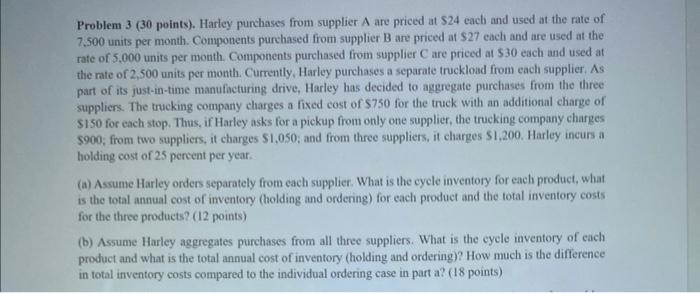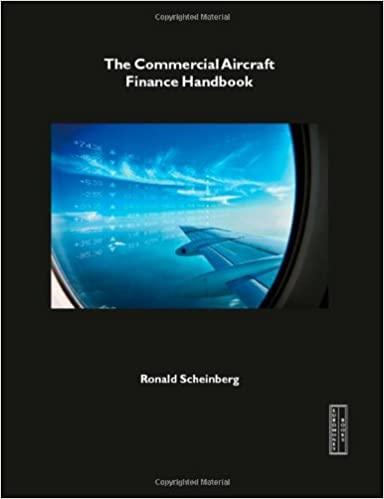
Problem 3 (30 points). Harley purchases from supplier A are priced at $24 cach and used at the rate of 7.500 units per month. Components purchased from supplier B are priced at $27 each and are used at the rate of 5,000 units per month. Components purchased from supplier C are priced at $30 each and used at the rate of 2,500 units per month. Currently, Harley purchases a separate truckload from each supplier. As part of its just-in-time manufacturing drive, Harley has decided to aggregate purchases from the three suppliers. The trucking company charges a fixed cost of $750 for the truck with an additional charge of $150 for each stop. Thus, if Harley asks for a pickup from only one supplier, the trucking company charges 5900 ; from two suppliers, it charges 51,050 ; and from three suppliers, it eharges $1,200. Harley incurs a holding cost of 25 percent per year. (a) Assume Harley orders separately from each supplier. What is the cycle inventory for each product, what is the total annual cost of inventory (holding and ordering) for each product and the total inventory costs for the three products? ( 12 points) (b) Assume Harley aggregates purchases from all three suppliers. What is the cycle inventory of each product and what is the total annual cost of inventory (holding and ordering)? How much is the difference in total inventory costs compared to the individual ordering case in part a? ( 18 points) Problem 3 (30 points). Harley purchases from supplier A are priced at $24 cach and used at the rate of 7.500 units per month. Components purchased from supplier B are priced at $27 each and are used at the rate of 5,000 units per month. Components purchased from supplier C are priced at $30 each and used at the rate of 2,500 units per month. Currently, Harley purchases a separate truckload from each supplier. As part of its just-in-time manufacturing drive, Harley has decided to aggregate purchases from the three suppliers. The trucking company charges a fixed cost of $750 for the truck with an additional charge of $150 for each stop. Thus, if Harley asks for a pickup from only one supplier, the trucking company charges 5900 ; from two suppliers, it charges 51,050 ; and from three suppliers, it eharges $1,200. Harley incurs a holding cost of 25 percent per year. (a) Assume Harley orders separately from each supplier. What is the cycle inventory for each product, what is the total annual cost of inventory (holding and ordering) for each product and the total inventory costs for the three products? ( 12 points) (b) Assume Harley aggregates purchases from all three suppliers. What is the cycle inventory of each product and what is the total annual cost of inventory (holding and ordering)? How much is the difference in total inventory costs compared to the individual ordering case in part a? ( 18 points)







